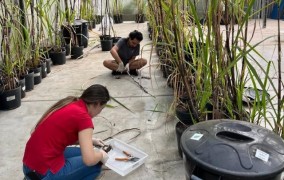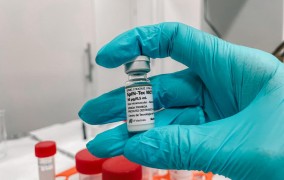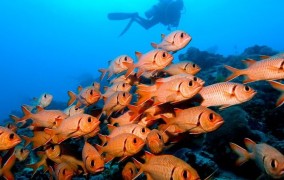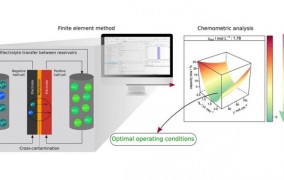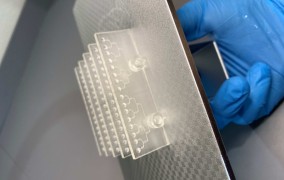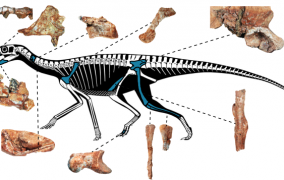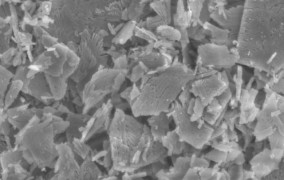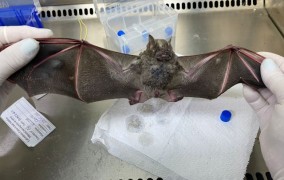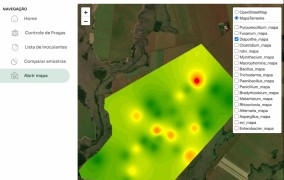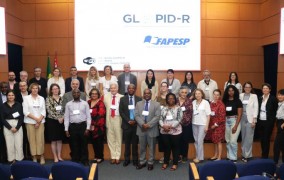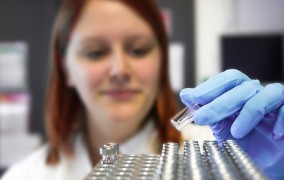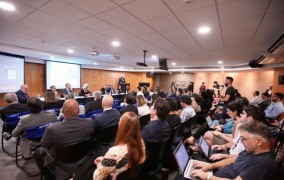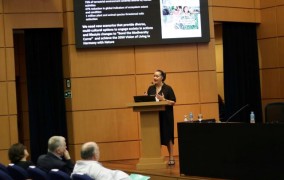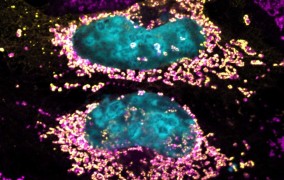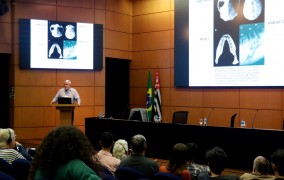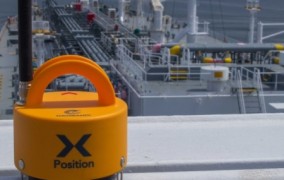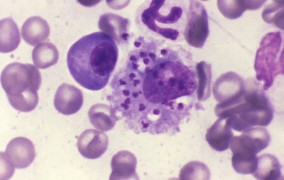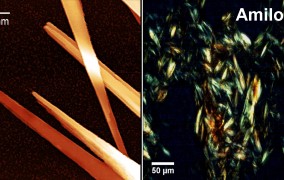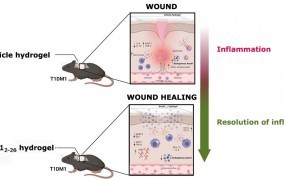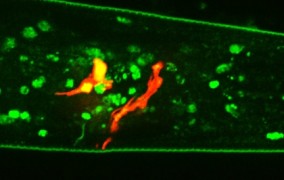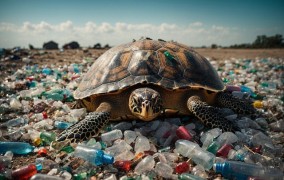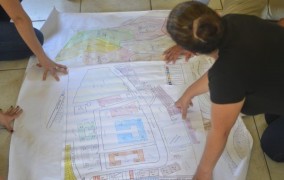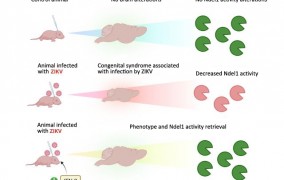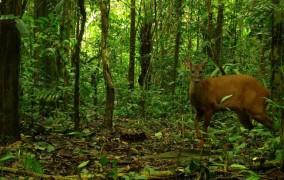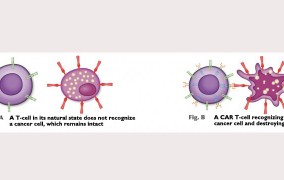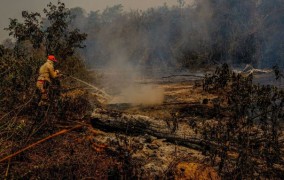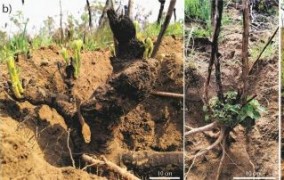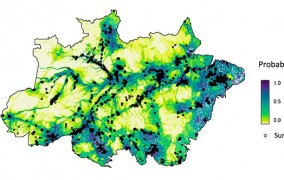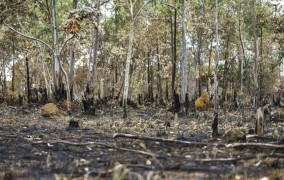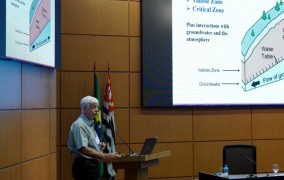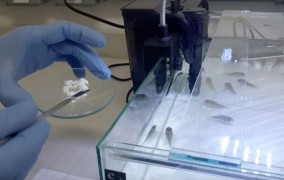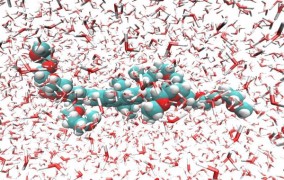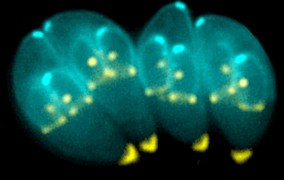
News
-
FAPESP strengthens research collaboration with Italy
2023-11-29Senior executives of the foundation visited leading Italian universities and scientific institutions with the aim of increasing collaboration. -
Review article shows key role of Brazil in research on sugarcane for bioenergy
2023-11-27The study by researchers at the University of São Paulo also shows that genetic engineering techniques need to be improved in order to increase ethanol production without expanding crop acreage, a strategy considered crucial to the effort to cope with climate change. -
A Brazilian vaccine may be the ideal choice for annual vaccination campaigns against COVID-19
2023-11-22Called SpiNTec, the vaccine can induce a more lasting immune response and should be more effective than vaccines currently available in Brazil against variants of the novel coronavirus SARS-CoV-2, according to the leader of the local vaccine development project, who took part in the FAPESP 2023 School in Exact and Natural Sciences, Engineering and Medicine. -
‘Science must go into corner stores, bars and homes,’ urges Brazilian astronomer who works with NASA
2023-11-22On a visit to São Paulo to participate in the FAPESP 2023 Interdisciplinary School in Exact and Natural Sciences, Engineering and Medicine, astrophysicist Duília de Mello argued that science popularization can combat epistemic bubbles. -
FAPESP and the University of São Paulo are participating in the Ocean Pavilion at COP28 in Dubai
2023-11-22A group of organizations led by Woods Hole Oceanographic Institution (WHOI) and the University of California San Diego’s Scripps Institution of Oceanography have established an online platform to raise the visibility of the ocean and highlight its importance to climate negotiations and life on the planet. -
Researchers obtain promising results against capacity loss in vanadium batteries
2023-11-22A computational study conducted by the Center for Development of Functional Materials at the Federal University of São Carlos (UFSCar) in Brazil could help extend the working lives of these batteries, which are widely used by utilities and manufacturers. -
Quick test analyzes DNA to improve crops
2023-11-22A technological solution developed by a Brazilian startup with FAPESP’s support detects microorganisms that cause disease in eucalyptus, soybeans and other agricultural plants. They can be detected in grains, leaves and the air. -
New fossil assemblage highlights complexity of classifying silesaurid phylogeny
2023-11-21The fossil assemblage was found in the state of Rio Grande do Sul, one of Brazil’s richest paleontological regions. The bones belonged to animals that lived between 247 million and 208 million years ago. It is difficult to confirm they can be considered species of dinosaur. -
Biomaterial developed at São Paulo State University proves capable of accelerating bone regeneration
2023-11-21In vitro experiments showed cobalt-doped calcium phosphate to be capable of stimulating bone cell differentiation by mimicking a low-oxygen environment. Next steps include animal testing. -
Identified a star capable of forming a magnetar, the most powerful type of magnet in the Universe
2023-11-15A little smaller than the Sun but ten times as hot, it will go supernova and become a neutron star with a magnetic field 100 trillion times stronger than Earth’s. -
In Northeast Brazil, rabies virus variants from marmosets are found in bats
2023-11-15The emergence of rabies in distinct wildlife species is a potential source of human infection and poses life-threatening risks. As the researchers responsible for the discovery warn, anyone who comes into contact with these animals should alert the authorities. A 36-year-old farm worker died in May, only weeks after being bitten by a marmoset. -
The crucial role of biofuels in the energy transition is explained in an encyclopedic new book
2023-11-15Written by two experts on biofuels, Luís Augusto Barbosa Cortez and Frank Rosillo-Calle, the book explores Brazil’s experience and how other countries can learn from it in the context of climate change. -
Platform identifies soil microorganisms that cause disease
2023-11-15Technology developed by the startup ByMyCell with the support of FAPESP helps farmers make decisions that boost yields and reduce the use of agrochemicals. -
Global funders of health-related research discuss epidemic and pandemic preparedness guidelines
2023-11-15The Ninth General Assembly of the Global Research Collaboration for Infectious Disease Preparedness, representing funding agencies, research institutions and government bodies from around the world, was held at FAPESP in São Paulo, Brazil, on October 24-25. -
Novel method facilitates study of oxidized lipids involved in neurodegenerative diseases
2023-11-14Scientists at the University of São Paulo’s Center for Research on Redox Processes in Biomedicine used a novel technique they themselves developed to identify altered molecules in an animal model of amyotrophic lateral sclerosis (ALS). -
Molecule tested at University of São Paulo proves able to mitigate heart failure
2023-11-08Results of trials involving animals, cell cultures and human heart tissue are reported in the European Heart Journal. The study was conducted by researchers at USP in partnership with a biopharmaceutical firm, offering hope to 2 million Brazilians who suffer from the disease. -
El Niño, climate change and deforestation: scientists explain what may lie behind the drought in the Amazon
2023-11-08Brazil’s North region is experiencing the worst drought of the century, with severe social and economic impacts. The problem was discussed at an event hosted by FAPESP on October 17. -
New center will use data and artificial intelligence to support public safety policymaking
2023-11-08FGV Analytics is a partnership involving FAPESP, Getúlio Vargas Foundation, the University of São Paulo and the São Paulo State Department of Public Safety. Its mission includes fostering development of evaluation tools and evidence-based public policy. -
Customizable corporate training system uses technology, immersion and interactivity
2023-11-08The platform was developed by a startup supported by FAPESP. It uses an adult learning methodology that leverages motivational techniques and customization. -
South African researcher presents novel ways of thinking about the relations between society and ecosystems
2023-11-08Laura Maureen Pereira delivered the Seventh 2023 FAPESP Lecture on “Why we need transformative scenarios for people and nature”. -
Open data sharing is essential to pursuit of sustainability solutions
2023-11-08This was a consensus among representatives of funding agencies in the Americas who met virtually in October under the aegis of the Global Research Council. A previous event discussed funding for research relating to artificial intelligence in Latin America. -
Study reveals bacterial protein capable of keeping human cells healthy
2023-11-08An article published in PNAS by Brazilian and Australian researchers describes a hitherto unknown protein with anti-oxidizing properties secreted by Coxiella burnetii, a Gram-negative intracellular bacterium, pointing to possible treatments for auto-immune diseases and even cancer. -
“We are not so much trying to improve our understanding of human evolution as trying to reduce our ignorance about it”
2023-11-01This is how Bernard Wood, one of the foremost paleoanthropologists alive, summed up his philosophy in the Sixth 2023 FAPESP Lecture. -
Research funding disbursed by FAPESP rose 16.7% in 2022 compared with the previous year
2023-11-01FAPESP increased research funding opportunities by creating new programs and new partnerships, according to its 2002 Annual Report. -
Novel portable device weighing less than 1 kg helps harbor pilots maneuver large vessels into port
2023-11-01High-precision maneuvering support system with integrated hardware and software developed by a startup supported by FAPESP transmits dynamic information in real-time via a smart platform. -
Test detects co-infection by novel species of parasite in severe cases of visceral leishmaniasis
2023-11-01The test developed by Brazilian researchers accurately identifies the causative agent in less than two hours, so that treatment can be properly targeted. Brazil is seeing a growing number of cases of co-infection by protozoans Leishmania infantum and Crithidia. -
Chemical process makes peptide acquire structure similar to amyloid plaques found in neurodegenerative diseases
2023-11-01Highlighted on the cover of the journal Biochemistry, a study by Brazilian researchers shows that a chemical change called pyroglutamination can occur spontaneously during peptide synthesis. The discovery has implications for laboratory experiments and research on Alzheimer’s, Parkinson’s and other diseases associated with the formation of amyloid aggregates. -
Better access to diagnostic tests raises incidence of thyroid cancer in more affluent areas
2023-11-01A study compared geographical and socioeconomic dimensions of the disease in São Paulo and the Barretos region. Incidence was far higher in the former but mortality rates were similar, suggesting overdiagnosis in specific areas and social groups. -
Hydrogel developed by Brazilian researchers improves skin wound healing in diabetics
2023-10-25The product, which contains the anti-inflammatory protein annexin A1, accelerated complete skin wound healing in mice, and has the potential to become part of the arsenal of treatments for a disease that affects 17.7 million Brazilians. -
Longevity may be associated with olfactory perception of harmful substances
2023-10-25In nematode worms exposed to a compound secreted by pathogenic bacteria, researchers observed activation of a neural circuit resulting in a longer lifespan and less protein aggregation, one of the causes of neurodegenerative diseases. The discovery paves the way for the development of treatments for age-related diseases. -
Products made of plastic falsely claimed to be biodegradable are on sale at Brazilian supermarkets
2023-10-25Researchers at the Federal University of São Paulo analyzed allegedly biodegradable plastic items sold by 40 supermarkets and found most to be oxo-degradables, banned in several countries because they contribute significantly to microplastic pollution. Bills currently before Brazil’s Congress would regulate the sale of such products. -
Method involving citizen participation is effective to address risks of environmental disaster
2023-10-25A research project showed that mobilizing citizens in flood-prone areas improves data collection and increases resilience. -
Study associates reduced activity of a key enzyme with microcephaly in zika-infected offspring
2023-10-25Brazilian researchers showed that brain activity of Ndel1, an enzyme that plays an important role in neuron differentiation and migration, decreased in mice infected by zika during pregnancy. The enzyme could become a biomarker for early diagnosis of the congenital syndrome associated with zika. -
Subsistence poaching has little impact on biodiversity in the Amazon’s environmental protection areas
2023-10-25A study conducted in sustainable-use reserves shows that local game species become less abundant about 5 kilometers away from the nearest human community, but the negative effects of anthropic activity can be mitigated by appropriate management strategies. -
Nutera Advanced Therapy Center will produce CAR T-cells for use in clinical trial of cancer treatment
2023-10-18Opened in 2022 with FAPESP’s support, Nutera is Latin America’s first cellular product manufacturing plant. It is run by researchers from Butantan Institute and the University of São Paulo’s Ribeirão Preto Blood Center, and could become a supplier to the SUS, Brazil’s public healthcare network. -
In 2020, 30% of the Pantanal was burned to cinders by wildfires
2023-10-18This is one of the findings of a study led by Brazilian scientists and reported in the science journal Fire. The researchers built a model based on images from the SENTINEL-2 satellite and were able to detect burned areas much more accurately. -
Study demonstrates antimicrobial action of polyalthic acid from copaiba oil
2023-10-18Findings reported in the journal Antibiotics by scientists working in Brazil and the United States pave the way for the development of drugs against resistant bacteria. -
Plants in the Cerrado combine at least two strategies to survive fire, study shows
2023-10-18Plant species native to the Brazilian savanna-like biome grow thick bark to protect their internal tissues and hide organs that assure resprouting below the ground, according to an article in Flora by researchers at São Paulo State University. -
Study reveals areas of Brazilian Amazon where no ecological research has been done
2023-10-16The findings evidenced high susceptibility to climate change by 2050 in 15%-18% of the areas with the most neglected biodiversity. -
FAPESP issues two new calls focusing on acceleration and internationalization of deep tech startups
2023-10-16The calls offer opportunities for accelerators and agencies that provide services for startups under the aegis of Tecnova III, a program run by the Brazilian Innovation Agency which in São Paulo is operationalized in partnership with FAPESP. -
Cerrado requires strict protection and rehabilitation of areas to curb deforestation, scientists warn
2023-10-11Record levels of destruction of native vegetation in the Brazilian savanna, the second-largest biome in South America, motivated the letter published in Nature Sustainability. The scientists who wrote it stress the need for specific measures to conserve the Cerrado’s rich biodiversity. -
Researcher who transformed soil physics and vadose zone hydrology delivers fifth 2023 FAPESP Lecture
2023-10-11Dutch-born scientist Martinus Theodorus van Genuchten is the author of a famous equation describing the hydraulic conductivity of unsaturated soil. His discoveries are central to agricultural operations and climate science, and he recently won the prestigious Wolf Prize in Agriculture. -
FAPESP seeks to attract investment in small enterprises that participate in its pro-innovation program
2023-10-11Two calls have been issued to register equity crowdfunding platforms and angel investor networks interested in investing in deep techs. -
Novel biomaterial delivers medication directly to fish gut
2023-10-11In addition to helping combat antimicrobial resistance, the bioparticle developed at the Federal University of São Paulo avoids the waste and pollution created by excessive amounts of drugs in water bodies. The strategy was tested on an ornamental fish species native to the Amazon and found to be safe. -
Absorption of light by molecules has applications in microscopy, medicine and data storage
2023-10-11An alternative method proposed by a Brazilian physicist cuts the time for computer simulation of the absorption spectrum from two days to a few hours. -
Perfect storm: poor sleep quality worsens health problems in obese older people, study shows
2023-10-10Research conducted at the University of São Paulo involving 95 volunteers associated poor sleep quality with a deterioration in the complications caused by aging and overweight, such as anxiety, depression, body fat gain, and loss of muscle mass and strength. -
Amazon+10 Initiative and CNPq issue new call to support scientific expeditions in the region
2023-10-04Subnational funding agencies and Brazil’s National Scientific Council will partner to allocate almost BRL 60 million to research projects that explore little-known areas of the world’s largest tropical forest. -
Researcher assessment criteria are changing globally
2023-10-04According to experts interviewed by Agência FAPESP, classic indicators based on numbers of articles and citations are being replaced by a multidimensional approach that encompasses teaching, research, extension, culture and outreach. -
FAPESP assembles experts to discuss the Amazon during UN Science Summit in New York
2023-10-04‘Amazon Day: Science for the Amazon’ was held on September 15, during the 78th United Nations General Assembly. Panelists discussed the role of science, technology and innovation in sustainable development for the region. -
Study identifies six drugs that can be repurposed for treatment of toxoplasmosis
2023-10-04Brazilian researchers screened 160 compounds known to be effective against SARS-CoV-2 and identified those that also act against the protozoan parasite Toxoplasma gondii. The most promising will be tested in humans for treatment of the chronic form of the disease.
Most popular
-
Amazon scorpion toxin kills breast cancer cells
2025-06-18
-
Spending more than 3 hours a day sedentary worsens teens’ mental health
2025-02-20
-
Climate change could drastically reduce aquifer recharge in Brazil
2025-09-17
-
Microplastics may affect bone health
2025-09-17
-
‘Science alone will not save us’: Paulo Jannuzzi highlights the need for republican values
2025-09-17
-
Butantan Institute says its dengue vaccine protects against serotype 3
2025-02-05
-
FAPESP aims to boost the development of quantum technologies in Brazil
2025-01-15
-
Molecule reverses cognitive deficits associated with aging and dementia in animal tests
2025-05-12
-
Ants defend plants from herbivores but can hinder pollination
2025-09-15
-
Personality traits influence the development of insomnia
2025-05-19






